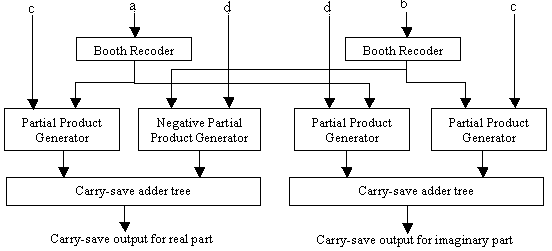Complex Number Multipliers
[Last modified 11:12:05 PM on Tuesday, 27 July 2010]A typical complex multiplication is (a + ib)(c + id), but to perform this calculation in hardware we need to separate the two components:
(a + ib)(c + id) = (ac - bd) + i(bc + ad)

Figure 1: Architecture for a complex multiplier circuit, based on the components of the original multiplier.
A further complication is that sometimes, in this particular project, it is necessary to multiply by the conjugate of the value that is read from the inputs. Explicitly taking the conjugate of those values would involve the problem of having to add "1" to the result, especially when we may need to do so again after the booth recoding. Instead, I found it was easier to incorporate this feature into the multiplier, after observing the output of such a calculation:
(a + ib)(c - id) = (ac + bd) + i(bc - ad)Alternative Approaches
There have been numerous designs for complex multiplication algorithms. Two particular approaches of interest are:
- [1] shows how some of the results can be reused to prevent redundant calculations. For (a+ib)(c+id), the real part of the answer is ac - bd. The imaginary part is bc + ad, but can also be expressed as (a + b)(c + d) - ac - bd. This requires one less multiplication, and three more additions. The algorithm involves using lookup tables and full adders to generate the result, but this technique was not feasible for this project.
- The use of the redundant binary number system for complex numbers is described in [2]. This number system involves the use of three possible values for each "bit", being -1, 0 and 1, to allow for more efficient arithmetic operations. Previous experience with this number system, for the previous multiplier project, did not make this a suitable candidate.
References
- [1] Y. B. Mahdy, S. A. Ali, K. M. Shaaban, "Algorithm and Two Efficient Implementations for Complex Multiplier",Proceedings of ICECS '99, vol 2, 1999, pp949-952
- [2] Kyung-Wook Shin; Bang-Sup Song, "A complex multiplier architecture based on redundant binary arithmetic", Proceedings of 1997 IEEE International Symposium on Circuits and Systems. Circuits and Systems in the Information Age. ISCAS 97, pp 1944-1947.